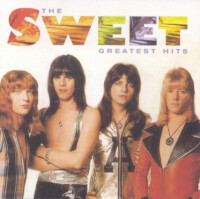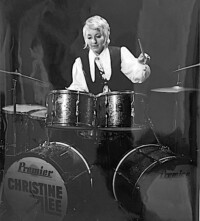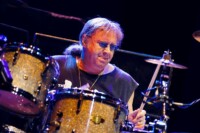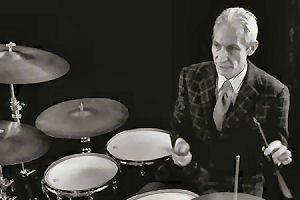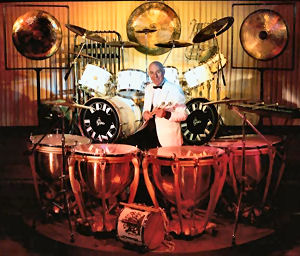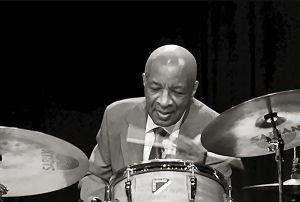 Edmund Leonard Thigpen was born in Chicago on December 28th, 1930 but moved to Los Angeles with his mother when his parents split up. His father Ben was a professional drummer and played in Kansas with a swing outfit called ‘Andy Kirks Clouds Of Joy’. These guys epitomised what became the Kansas City Sound and Ben Thigpen was evidently not just a great drummer, he was also a fantastic showman.
Edmund Leonard Thigpen was born in Chicago on December 28th, 1930 but moved to Los Angeles with his mother when his parents split up. His father Ben was a professional drummer and played in Kansas with a swing outfit called ‘Andy Kirks Clouds Of Joy’. These guys epitomised what became the Kansas City Sound and Ben Thigpen was evidently not just a great drummer, he was also a fantastic showman.
Ed was brought up in LA and eventually went to Thomas Jefferson High school which was where quite a few other renowned jazz musicians, such as Chico Hamilton, had studied. He started out on piano at school but changed to the drums without his father knowing. After one year studying sociology he dropped-out realising it wasn’t what he wanted to do with his life and moved to St Louis, where Ben had relocated. When he arrived in Missouri his father was leading his own successful quintet and there is a rumour that when Ed got into his stride in St Louis he jammed a few times with Miles Davis.
Ed turned professional at 18 years old with Buddy Colette, and his principal influences were his father Ben and Count Basie’s drummer Jo Jones. Realising where the real action was taking place, in 1951 he moved to New York to play with Cootie Williams at the Savoy Ballroom as well as with the likes of Dinah Washington, Eddie Vinson, Oscar Pettiford, Johnny Hodges, Bud Powell, Billy Taylor and a jazz harpist named Dorothy Ashby (who later ‘crossed-over’ to play with Bill Withers, Minnie Ripperton, Stevie Wonder and Earth, Wind and Fire!) It was around this time he acquired the title which stayed with him all his life: ‘Mr Taste’.
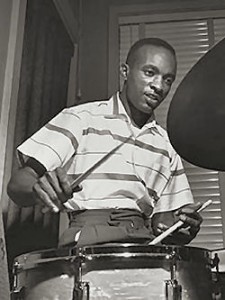 In 1952 he was conscripted into the US 8th Army during his stint at the Savoy and drafted to Fort Ord in California where he was a drum instructor, before eventually being sent to Korea to take part in the ‘Forgotten War’. As it happens this turned out to be a huge break for him because while he was in Tokyo indulging in some rest and recuperation far away from the war, he went to see Oscar Peterson playing in one of a highly successful and long running series of concerts called ‘Jazz at the Philharmonic’. Ed realised he just had to play with him. Not an easy task because at the time Oscar didn’t actually have a drummer as Herb Ellis was playing guitar and providing the necessary rhythm! Anyhow he confided in Ray Brown, who was Oscar’s bassist, that he really wanted the gig and Ray passed his ambition on to Oscar Peterson.
In 1952 he was conscripted into the US 8th Army during his stint at the Savoy and drafted to Fort Ord in California where he was a drum instructor, before eventually being sent to Korea to take part in the ‘Forgotten War’. As it happens this turned out to be a huge break for him because while he was in Tokyo indulging in some rest and recuperation far away from the war, he went to see Oscar Peterson playing in one of a highly successful and long running series of concerts called ‘Jazz at the Philharmonic’. Ed realised he just had to play with him. Not an easy task because at the time Oscar didn’t actually have a drummer as Herb Ellis was playing guitar and providing the necessary rhythm! Anyhow he confided in Ray Brown, who was Oscar’s bassist, that he really wanted the gig and Ray passed his ambition on to Oscar Peterson.
Time went by and after his demob Ed returned to New York and got on with playing first with Dinah Washington then Billy Taylor and it wasn’t until four years later (1959) that he got the call to join the Oscar Peterson Trio. Initially he says he priced himself out of the deal and thought he’d lost his chance, but fortunately, in the fullness of time, Oscar got back to him and the rest really is history (even though nobody knows whether he got the salary he was looking for!).
Ed Thigpen stayed with that trio until 1967 and literally toured the whole world. It wasn’t any ordinary gig by any manner of means because these guys were not only frighteningly tight, according to Ed they played every piece as if it were an opener or a closer, but Oscar insisted that their performance on a bad night be better than anybody else’s on a good night. The rapport between the three of them was uncanny and their performances were absolutely flawless. They swung hard and seemingly effortlessly. I went to see them at the Hickory House in Chicago and I came out absolutely buzzing at their expertise.
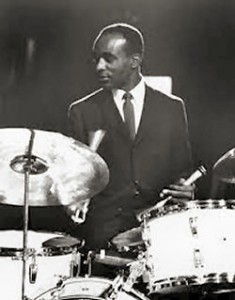 Ed Thigpen became an educator and taught at Oscar Peterson’s music school in Canada. Upon leaving The Peterson Trio in 1967, having made no less than 50 albums with them, he joined up with Ella Fitzgerald who loved his understated and melodic playing and he stayed with her for five years before heading for Scandinavia. From 1966 though he was in demand for recording sessions in Los Angeles – playing with an extremely diverse bunch of artists such as Pat Boone, Johnny Mathis, Andy Williams, Peggy Lee and Oliver Nelson.
Ed Thigpen became an educator and taught at Oscar Peterson’s music school in Canada. Upon leaving The Peterson Trio in 1967, having made no less than 50 albums with them, he joined up with Ella Fitzgerald who loved his understated and melodic playing and he stayed with her for five years before heading for Scandinavia. From 1966 though he was in demand for recording sessions in Los Angeles – playing with an extremely diverse bunch of artists such as Pat Boone, Johnny Mathis, Andy Williams, Peggy Lee and Oliver Nelson.
He played Ludwig drums for a long time and appeared in their 1960 and 1962 catalogues as Edmond Thigpen with an ‘O’. Curious because everywhere I’ve looked his Christian name was spelled Edmund with a ‘U’. Anyhow by the time he was in the ‘67 catalogue (where Ringo appeared for the first time) he was simply called Ed. He stayed with Ludwig until his good friend Remo Belli produced a professional quality drum kit in the mid-eighties and he got on board.
Ed Thigpen was an able educator and I frequently saw him at the music shows showing his prodigious technique and ability and passing it on to anybody who was interested. I sat with him and Remo Belli in a Chinese restaurant in Frankfurt during the Music Trade fair and since he’d been doing sessions that day at the show he had his stick-bag with him. He opened it up and I was amazed (and secretly pleased) to discover the very ends of the wires of his brushes were bent, just like mine! I couldn’t resist making a joke about it but of course as Lance Armstrong would once candidly write: “It‘s not about the bike”. The condition of your brushes is immaterial, it’s the way you use them that counts. And Ed certainly could use them, even if their tines were bent at right angles.
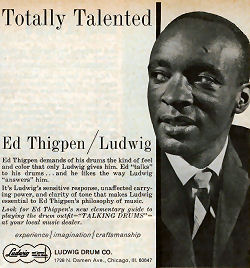 It’s fair to say he actually had two careers, the one in his homeland and then another in Denmark to where he moved in 1972 and began a family with his Danish wife. He began play with other exiled Americans who had relocated there like Milt Jackson, Kenny Drew, Thad Jones and Clark Terry; as well as young Danish guys who he brought into his ‘Scantet’. He started a drum studio or two and began to write tutor books and later DVDs. He was also the subject of a documentary film called ‘Ed Thigpen, Master of Time’. Towards the end he had Parkinson’s disease but it didn’t put an end to his playing – he just kept going.
It’s fair to say he actually had two careers, the one in his homeland and then another in Denmark to where he moved in 1972 and began a family with his Danish wife. He began play with other exiled Americans who had relocated there like Milt Jackson, Kenny Drew, Thad Jones and Clark Terry; as well as young Danish guys who he brought into his ‘Scantet’. He started a drum studio or two and began to write tutor books and later DVDs. He was also the subject of a documentary film called ‘Ed Thigpen, Master of Time’. Towards the end he had Parkinson’s disease but it didn’t put an end to his playing – he just kept going.
Even though I never had to play with brushes a great deal there were times when I did (even with the Kinks) and I always felt I was OK with them. But compared with the way Ed played them, like most drummers my prowess could best be described as adequate. Most drummers were absolutely in awe of him. He took the art to another level and not to beat around the bush, Buddy Rich and Gene Krupa are both on record saying Ed Thigpen was the best in the world on brushes!
To hear Ed Thigpen at his best you simply have to listen to absolutely anything by him! But listen to ‘My Fair Lady Loves Jazz’ with Billy Taylor in 1957 (which was arranged by Quincy Jones) and another stab he had at ‘My Fair Lady’ in 1958 along with ‘Night Train’ in 1962, both with Oscar Peterson. ‘Out Of The Storm’ was his own album on verve in 1966 and ‘Mr Taste’ which was also his own work and came out in 1992.
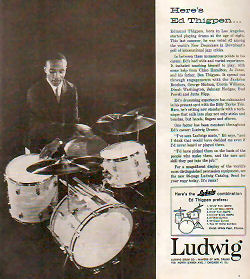 As an educator he had definite ideas on how jazz should be played, especially what the bass drum should be doing when the pulse of ‘time’ had moved up to the ride cymbal and the bass drum would be bombing the accents. Ed Thigpen said that: “Even in high school we argued about it. Then I saw Max Roach in New York and he played the bass drum, 1-2-3-4. I asked my father, and Jo Jones, and Sid Catlett. They said you `feather’ the bass drum. You have a pulse that is felt. You don’t beat it; you just feather it. And when you want a `bomb,’ you just bring that beater back and hit the drum with a big, loud stroke. Then you get back to the pulse, because with that you can hold the band together.”
As an educator he had definite ideas on how jazz should be played, especially what the bass drum should be doing when the pulse of ‘time’ had moved up to the ride cymbal and the bass drum would be bombing the accents. Ed Thigpen said that: “Even in high school we argued about it. Then I saw Max Roach in New York and he played the bass drum, 1-2-3-4. I asked my father, and Jo Jones, and Sid Catlett. They said you `feather’ the bass drum. You have a pulse that is felt. You don’t beat it; you just feather it. And when you want a `bomb,’ you just bring that beater back and hit the drum with a big, loud stroke. Then you get back to the pulse, because with that you can hold the band together.”
He was positively evangelical about this particular facet of drumming. “Playing the bass drum is part of the heritage and should be part of the training that goes into learning how to play the set, because it is fundamental to the instrument. Once these fundamental rules have been mastered, then you can take liberties and know how and why you are doing what you’re doing. The set has been taught in a wrong manner because of this particular misconception of the role of the bass drum. It’s like going for the roof before putting down the foundation. There are certain basic truths about this instrument, which are not being put into perspective.”
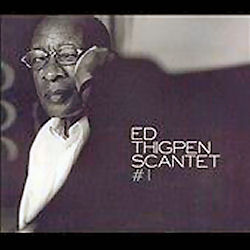 “I’ve always felt I’ve been a member of a luxury profession,” he said to Modern Drummer. “I’m thankful I’ve had the opportunity to be a part of it. Just the idea of playing music – the rapport between a group of musicians when that magic happens, the gratification when it works. You can’t put a dollar sign on the love and joy one receives out of being able to participate. To my way of thinking, it’s about as close to heaven as one is going to get on this earth.”
“I’ve always felt I’ve been a member of a luxury profession,” he said to Modern Drummer. “I’m thankful I’ve had the opportunity to be a part of it. Just the idea of playing music – the rapport between a group of musicians when that magic happens, the gratification when it works. You can’t put a dollar sign on the love and joy one receives out of being able to participate. To my way of thinking, it’s about as close to heaven as one is going to get on this earth.”
Ed Thigpen died in Copenhagen on January 13th, 2010 and one of his obits was on the World Socialist website which defined him as: “an underrated drummer in his field”. No drummer I know would have talked of him in those terms. To us he was always very highly-rated – in any field he chose!
All his other obits described him as the most tasteful of drummers and said his drumming was like the spring of a Swiss watch. To add to that I’d say in my experience, he was also a very gentle man.
Bob Henrit
August 2014

